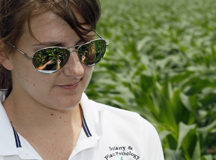Fungicides may not increase corn yields unless disease develops

Kiersten Wise's research shows that fungicide use on corn without the presence of disease does not produce higher yields. (Purdue Agricultural Communication photo/Tom Campbell)
WEST LAFAYETTE, Ind. - Unless a corn crop is at risk of developing fungal diseases, a Purdue University study shows that farmers would be smart to skip fungicide treatments that promise increased yields.
Kiersten Wise, an assistant professor of botany and plant pathology, said fungicides used in fields where conditions were optimal for fungal diseases improved yields and paid for themselves. In fields where fungal diseases are unlikely to develop, however, applying a fungicide is likely a waste of money.
"About five years ago, we never used fungicides in hybrid corn. Then there was this push to use fungicides for yield enhancement, even without disease problems," said Wise, who collaborated on findings that were published as an American Phytopathological Society feature article in the journal Phytopathology. "We found that you would have to get a substantial yield increase for a fungicide treatment to pay for itself. We didn't see that yield increase on a consistent basis, and it wasn't predictable."
Wise and her collaborators reviewed published data from foliar fungicide tests in 14 states, as well as data from their own research plots, to determine which circumstances led to yield increases when fungicides were used. They found that a combination of several factors that would contribute to fungal disease - no-till fields, fungus-susceptible hybrids, continuous corn, wet field conditions, etc. - needed to be present for yields to increase with fungicide applications.
"In our trials, even where conditions were optimal for disease, if disease didn't develop, we didn't see a yield increase," Wise said.
Growers need to weigh the cost of the treatments - usually $32-$34 per acre - against the possible benefits and the price of corn. At low corn prices, it takes a larger yield increase to recoup the cost of a fungicide application.
Wise said the general rule was that growers needed to see a yield increase of about six bushels per acre to recover their investment.
Wise collaborated with researchers from Iowa State University, University of Illinois, University of Minnesota, Mississippi State University, University of Maryland, University of Kentucky, University of Wisconsin, and the Ohio Agricultural Research and Development Center.
Wise said she would continue research to determine more specific guidelines for when fungicide applications increase profits. The Indiana Corn Marketing Council funded the work.
Writer: Brian Wallheimer, 765-496-2050, bwallhei@purdue.edu
Ag Communications: (765) 494-2722;
Keith Robinson, robins89@purdue.edu
Agriculture News Page
ABSTRACT
Meta-Analysis of Yield Response of Hybrid Field Corn to Foliar Fungicides in the U.S. Corn Belt
P. A. Paul, L. V. Madden, C. A. Bradley, A. E. Robertson, G. P. Munkvold, G. Shaner, K. A. Wise, D. K. Malvick, T. W. Allen, A. Grybauskas, P. Vincelli, and P. Esker
The use of foliar fungicides on field corn has increased greatly over the past 5 years in the United States in an attempt to increase yields, despite limited evidence that use of the fungicides is consistently profitable. To assess the value of using fungicides in grain corn production, random-effects meta-analyses were performed on results from foliar fungicide experiments conducted between 2002 and 2009 in fourteen states across the U.S. to determine the mean yield response to the fungicides azoxystrobin, pyraclostrobin, propiconazole + trifloxystrobin, and propiconazole + azoxystrobin. For all fungicides, the yield difference between treated and nontreated plots was highly variable among studies. All four fungicides resulted in a significant mean yield increase relative to the nontreated (P < 0.05). Mean yield difference was highest for propiconazole + trifloxystrobin (390 kg/ha), followed by propiconazole + azoxystrobin (331 kg/ha) and pyraclostrobin (256 kg/ha), and lowest for azoxystrobin (230 kg/ha). Baseline yield (mean yield in the nontreated plots) had a significant effect on yield for propiconazole + azoxystrobin (P < 0.05), whereas, baseline foliar disease severity (mean severity in the nontreated plots) significantly affected the yield response to pyraclostrobin, propiconazole + trifloxystrobin and propiconazole + azoxystrobin, but not to azoxystrobin. Mean yield difference was generally higher in the lowest yield and higher disease severity categories than in the highest yield and lower disease categories. The probability of failing to recover the fungicide application cost (ploss) also was estimated for a range of grain corn prices and application costs. At the 10-year average corn grain price of $0.12/kg ($2.97/bushel) and application costs ranging from $40/ha to $95/ha, ploss for disease severity < 5% ranged from 0.55 to 0.98 for pyraclostrobin, 0.62 to 0.93 for propiconazole + trifloxystrobin, 0.58 to 0.89 for propiconazole + azoxystrobin, and 0.91 to 0.99 for azoxystrobin. When disease severity was > 5%, the corresponding probabilities ranged from 0.36 to 95, 0.25 to 0.69, 0.25 to 0.64, and 0.37 to 0.98 for the four fungicides. In conclusion, the high ploss values found in most scenarios suggest that the use of these foliar fungicides is unlikely to be profitable when foliar disease severity is low and yield expectation is high.
